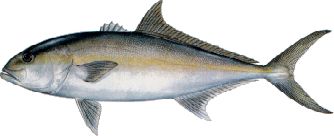Family: Carangidae
Description: A dark stripe (variably present) extends from nose to in front of dorsal fin and “lights up” when fish is in feeding mode, no scutes, the soft dorsal base less than twice the length of the anal fin base.
Similar Fish: Other species in the Seriola genus
Where found: Greater amberjack are an offshore species associated with rocky reefs, debris, and wrecks. They are typically in 60 – 240 feet of water and sometimes caught nearshore in south Florida. Juveniles are associated with floating objects and may occur in water less than 30 feet deep.
Size: Common to 40 pounds
*Florida Record: 142 lbs, caught near Islamorada
Remarks: Great amberjacks are the largest of the jacks. These fish are thought to spawn offshore throughout most of the year. They feed on squid, fish, and crustaceans.


